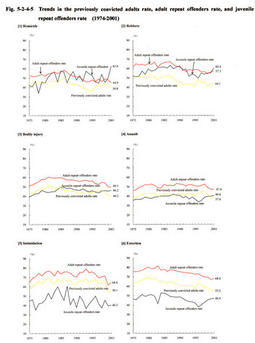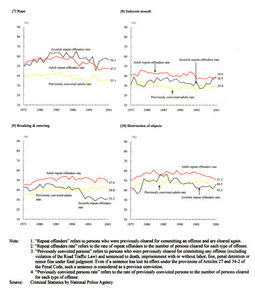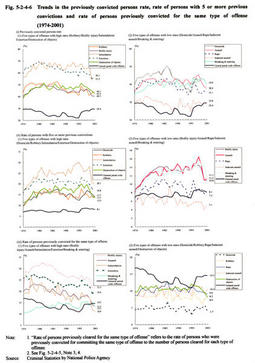| Previous Next Index Image Index Year Selection | |
|
|
4 Characteristics of repeat offenders The term "repeat offenders" could refer to various different concepts, but in the 2002 White Paper on Crime, it is defined as referring to persons who were previously cleared for committing an offense and have been cleared again (different from repeat offenders provided in Article 56 of the Penal Code). The repeat offenders rate refers to the rate of repeat offenders to the number of persons cleared. "Previously convicted persons" refers to persons who were previously cleared for committing any offense (excluding violation of the Road Traffic Law) and sentenced to death, imprisonment with or without labor, fine, penal detention or minor fine under final judgment. The previously convicted persons rate refers to the rate of previously convicted persons to the number of persons cleared.
Fig. 5-2-4-5 shows the trends in the previously convicted persons rate and the repeat offenders rate for homicide and the 9 types of violent offenses. The adult repeat offenders rate has generally been flat or slightly decreasing, but it was over 60% for robbery, intimidation and extortion and slightly less than 40% for indecent assault in 2001. Comparing adults and juveniles, the juvenile repeat offenders rate was higher for homicide, robbery, rape and indecent assault whereas the adult repeat offenders rate was higher for other 6 types of offenses in 2001. The previously convicted adults rate has been lower than the adult repeat offenders rate by about 10% except for homicide. This gap shows the rate of persons who had not been given penal sentences due to the reason such as being under 20 years of age when previously cleared. Fig. 5-2-4-6 (i) shows the trends in the previously convicted persons rate for homicide and the 9 types of violent offenses, while also indicating the previously convicted persons rate for general penal code offenses for the comparative purpose. All through the period since 1974, the previously convicted persons rate for these focused types of offenses except for indecent assault has been higher than the average rate for general penal code offenses. In particular, the rates for intimidation and extortion have been over 50% throughout the period. Fig. 5-2-4-6 (ii) shows the trends in the rate of persons with 5 or more previous convictions to the number of persons cleared for homicide and the 9 types of violent offenses. Throughout the period, the rate for these focused types of offenses except for rape and indecent assault has been higher than the average rate for general penal code offenses. In 2001, persons cleared with 5 or more convictions accounted for 10% or over in respect of all of these focused types of offenses. This indicates that these focused types of offenses are frequently committed by those with an advanced criminal tendency. Fig. 5-2-4-6 (iii) shows the trends in the rate of persons previously convicted for committing the same type of offense to the number of persons cleared for homicide and the 9 types of offenses. The rate was high for bodily injury, assault, intimidation, extortion and breaking and entering, but the rates for the former 4 types of offenses have been on a downward trend. However, the rates for bodily injury and extortion were still at around the 20% level, which is higher than the average rate for general penal code offenses. The previously convicted persons rate and the rate of persons with 5 or more previous convictions were relatively high, whereas the rate of persons previously convicted for the same type of offense was low in respect of the focused types of offenses, which indicates that most of those who committed these types of offenses had repeatedly committed not only the same types of offense as that for which they had been previously convicted but also other types of offenses. This subsection overviews the characteristics of repeat offenders when they were cleared. For the status of repeat convicts in correctional institutions, please see Part 5, Chapter 4, Section 1 . Fig. 5-2-4-5 Trends in the previously convicted adults rate, adult repeat offenders rate, and juvenile repeat offenders rate (1974-2001) Fig. 5-2-4-6 Trends in the previously convicted persons rate, rate of persons with 5 or more previous convictions and rate of persons previously convicted for the same type of offense (1974-2001) |


